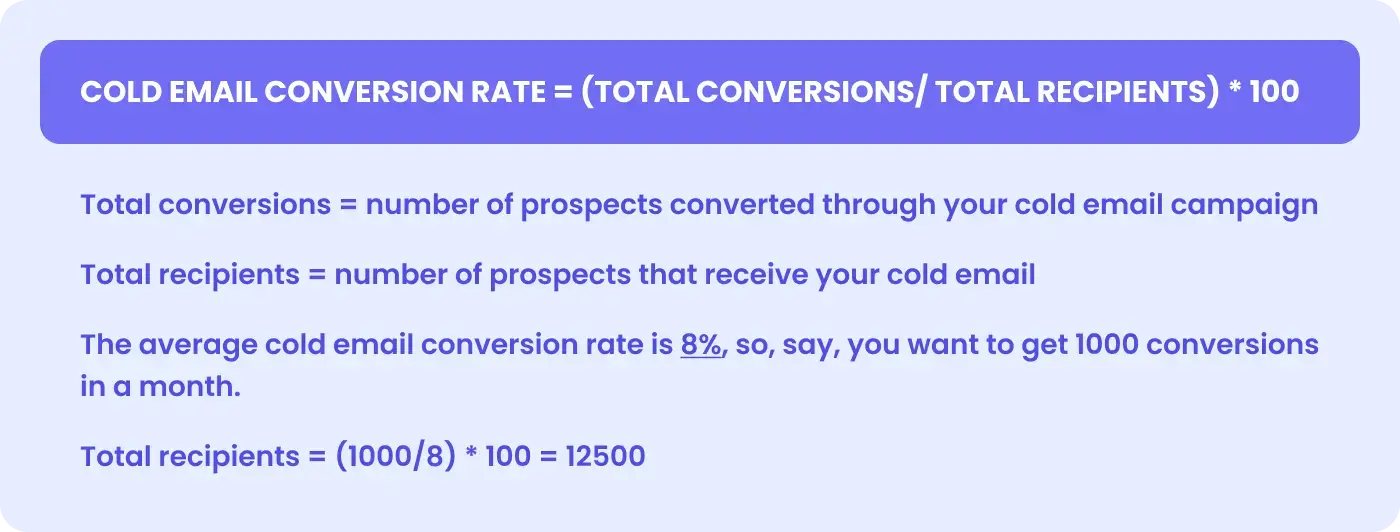Paul has been tasked with sending cold emails to rope in new leads.
He gives it a lot of thought and comes up with a supposedly unbeatable strategy to crush his quota: More cold emails = more possible responses = more leads.
Paul has a doomed plan.
Thanks to spam filters, sending out too many cold emails at once to different prospects increases the chances of getting marked as spam. Also, sending 3 cold emails to one prospect on the same day can damage sender reputation and hamper email deliverability.
So, how many cold emails can you send safely without activating the notorious spam filter? How do you create large-scale automated cold email campaigns? And how many cold emails should you actually be sending to hit your quota? Find out in this blog.
How Many Cold Emails To Send Per Day Without Triggering Spam Filters?
If you are an SDR with a new inbox and sending address, start by sending 10-20 cold emails per day to avoid getting penalized by the spam filter.
However, if you have an older inbox and sending address and a good email reputation, you can send over 100 emails daily, depending on your email service provider (ESP).
Popular ESPs like Gmail and Microsoft allow you to send different numbers of emails based on your organization’s plan.
Gmail allows you to send 500 emails daily to up to 500 different recipients. Plus, if you have a good reputation (decent open rates, being marked as 'not spam,' etc.), the ESP will trust you and deliver your message to your prospect's primary inbox.
Suppose your company has opted for Google Workspace, the email limit is much higher, up to 2000 emails per day. That number is 1500 for multi-send emails and 500 for trial accounts.
Microsoft Office 365 has a maximum email limit of 10,000 recipients per day for all its plans. Office 365 verifies your email's authenticity using DomainKeys Identified Mail (DKIM) and Sender Policy Framework (SPF). This ensures your emails reach the right inbox.
How Many Cold Emails To Send Per Day as a Sales Rep?
Sales reps can easily send up to 100 emails per day without attracting the attention of spam filters.
That said, the ideal number of cold emails you should send depends on your sales strategy. Ideally, you want to convert at least as many leads as the number of sales you make, preferably more. If you know your cold email conversion rate, you can calculate backward to arrive at the total number of leads.

So, your SDR team will need to send 12500 emails across 30 days or 416 per day.
Now if you have an SDR team of 4, each rep will send about 100 emails daily.
But don’t just take our word for it. Here’s how many emails top-performing SDRs send out daily.
- Alastair Chamberlin sends 100-150 cold emails every day, including automated and one-off emails.
- Nikita Solberg sends about 100 cold emails daily.
- Ashley Dees sends sales outreach emails to 10 to 12 accounts with 2 to 3 prospects each. That amounts to 36 emails per day.
Of course, take into consideration their average deal size and their average sales cycles as well. The number of emails you send a day will be fewer if your cold email campaigns have a highly targeted, niche set of audience.
How To Determine the Number of Cold Emails To Send?
1) Your Target Industry
Each industry has a unique appetite for cold emails. This depends on 2 things:
- How your people within the industry go about their day
- How they communicate professionally
For example, in the fast-paced and highly competitive technology industry, decision-makers typically receive a larger volume of cold emails, sometimes up to 20 per day, and they check their emails several times a day. So, it makes sense to try to get in touch with them via email.
So, sending 100 well-crafted emails a day to multiple prospects can be more acceptable.
On the other hand, if you're targeting the gaming industry with a young, tech-savvy audience, they'll be more responsive to social media DMs than your cold emails, because that’s where they live and communicate.
If you aren’t sure how many emails to send to prospects in your target industry, ask these questions.
- What does your ICP look like? (If you haven’t fleshed this out yet, think of one target company that needs your solution. Check their Crunchbase profile to get all the relevant business information.)
- Are they in an industry that receives cold emails?
- What buyer personas are you targeting? Or what is your ideal customer’s job description? (This can help you determine if your prospects have the time or authority to respond to cold emails. An engineer is less likely to respond to your sales cold emails than a decision-maker.)
- What is your goal with cold emailing? (If you want to gain conversions quickly through cold emailing, you want to adopt a more aggressive approach.)
2) How Long You Have Been Sending Cold Emails
As discussed earlier, the number of cold emails you should send depends on how old your inbox is.
When you have a new sending address and a new inbox:
Here, you don’t have a history of sending emails to vouch for you. So your internet service provider (ISP) assigns you a low sender reputation score, triggering the spam filter.
Now, if you send a large volume of emails, many of them could get marked as spam, lowering your reputation, and impacting your deliverability. Besides, once your email is flagged as spam, regaining the ESP's trust and reaching your recipient's inbox can be an uphill task, even with legitimate email copies.
So start small. Send only 10-20 targeted cold emails per day. If your email sending behavior is not suspicious, you can avoid setting off spam filters. That means higher email deliverability.
Couple this with a well-crafted cold email, and you can improve your open rates. (Our research suggests personalizing with your prospect’s company name can get you a 20% higher open rate.) These efforts will help you establish trust with the ESP by showing your emails are valuable. And that builds a positive sender reputation.
Pro tip: Run your emails through a spam checker before sending them to boost deliverability. Litmus has a spam testing tool to scan your emails across popular spam filters, allowing you to fix issues quickly.
When you have an older sending address:
Here, you most likely have an established sender reputation. So, even if you send out 100 cold emails daily, you don’t risk landing in the spam-hole, given your higher sender reputation score.
Have a low sender reputation score despite having an older sending address? Damage control with these steps:
- Identify the ISP (if you’re using different email providers for cold emailing)
- Contact the administrator and send your report
- Turn your email automation with higher send volumes off
- Focus on increasing sending reputation by driving email engagement, then increase the volume
If none of the above work (or you’re short on time), get a new sending address.
Can I Send 50, 100, 500, or 2000 Emails at Once?
Yes. And no.
You cannot send 50, 100, or 2000 emails at once using a standard ESP like Gmail. And especially not if you’re changing your email-sending behavior from 20 to 2000 all in a week. Reason? You’ll attract suspicion from the ESP, and your carefully crafted cold emails will wind up in the junk.
Instead, you can use a cold emailing tool like Klenty to send up to 500 emails out at random intervals. This way, your email activity doesn’t draw unwanted attention.
P.S: The key to sending bulk emails while avoiding email spam filters is changing your email-sending behavior gradually before deploying a bulk cold email effort. This brings us to our next tactic:
Warming up your inbox
Sending emails at lower limits first and gradually increasing volume does 3 things:
- Improves your sender reputation
- Improves email deliverability
- Increases open rate
But how?
When you warm up your inbox, you send 10-20 sales emails, preferably to your friends, colleagues, or prospects who know you or your product. These people are more likely to open your emails, so your ESP understands that your emails are valuable to your recipients.
Doing this over and over improves your sender reputation.
Pro-tip 1: You can track your sender reputation using a tool like Sender Score.
Pro-tip 2: You can ask your email recipients to add your emails to their inbox if they land in the spam folder too.
ESPs and ISPs will now view your better sender reputation and deliver emails straight to the email inbox. Ergo, better deliverability.
Above all, a better presence in your prospect’s inbox will automatically translate into better open rates if you follow the best practices for cold emailing.
Continue this practice for 10 to 12 weeks to warm up your new email account. Or use a tool like Warmup Inbox to automate this entire process.
If you use a tool, check the following:
- Does the tool use real accounts to warm up your inbox? (Preferably yes)
- Does the tool send unintelligible emails? (Preferably no)
- Does the tool enable email engagement? (Preferably yes)
How To Send 1000 Emails at Once?
With your inbox warmed up and email addresses verified, you're halfway there. Here are some more things to tick off the checklist:
1) Segment Your Prospect List
If your idea of sending bulk emails is to blast the same message to every last prospect on your email list, you're bound to be blacklisted.
Segment your prospects into groups with similar interests, pain points, industries, locations, etc. This way, you can ensure they receive just the information they want. Such targeted emails increase your engagement and keep your prospects from hitting spam.
If you’re using a CRM, you can quickly segment your buyers with these steps:
- Check if your CRM has updated prospect information
- Check if your CRM collects the necessary information for segmentation (for example, if you want to segment your prospects by their behavioral cues, your CRM should store this data)
- Check if your CRM tags information based on the segments you want to create
- Choose a segmentation approach that captures your ICP effectively
Finally, segment your contacts to create a cold email list.
2) Eliminate Inactive Emails
When your mail servers see many of your emails remain unopened, it sends any new emails straight to spam. Not to mention a high email bounce rate that further affects your reputation. This, coupled with sending 2000 emails per day, is enough to frame you as a serial spammer.
To do this:
- Identify unengaged prospects
- Check the reasons for bounces
- Send a re-engagement email to engage your prospects
And if those methods don’t work, strike those prospects’ details off your list.
Now, if you use an email sequence software to automate your cold email campaigns, check if your tool offers the list scrubbing feature. These days, services like Reoon also clean your email lists.
3) Set Up Your Email Infrastructure
If you use Klenty to connect to your Gmail or Outlook account, then this will be taken care of. But if you are setting up an SMTP server on a dedicated IP using a service provider like Sendgrid, Rackspace, or any proxy servers, then pay attention. You need to add the appropriate SPF and DKIM records and verify ownership of your domain, so the recipient can trust the emails sent by you.
Before setting up your cold email campaign, you have to set up your email infrastructure, because even if you’ve personalized all your emails and targeted the right prospects, you can still get filtered out by spam filters.
4) Personalize Your Email
Sending 1000 emails at one go doesn’t mean you cannot personalize your emails. Cold emailing tools like Klenty allow you to do the basics, like name and company-level personalization and other powerful personalizations.
Remember, the more relevant your content is to the prospect, the less likely your prospects will mark you as spam.
5) Use a Cold Email Tool
A high-quality cold email tool can send a large volume of personalized cold emails. All you need to do is follow these steps.
- Select the right tool: List down your requirements and see if the features of the tools align with them. Consider factors like deliverability rates, personalization capabilities, automation options, ease of use, etc. Read customer reviews on platforms like G2 and ask for a demo before you finalize the tool.
- Import your data: Import your prospect list to the cold email tool from your CRM. You can import the extra details as well—like industry, job role, location, etc. This will help you personalize based on accounts or different segments.
- Execute multichannel outreach: Many sales engagement tools today allow you to cold contact prospects via LinkedIn, email, and calls. So don’t just send cold emails, execute outreach via multiple channels to go where your prospects are.
- Get high conversion email templates: Create a cold email template for every step of your outreach—the first email, follow-up, handling objections, sharing resources, etc. Most cold email tools come with a great set of cold emails and follow-ups you can directly start using.
- Personalize your emails: Use the tool's personalization feature to further customize your cold emails.
- Check compliances: Use the cold email tool to ensure your cold emails are legal and comply with regulations like CAN-SPAM and GDPR.
- Monitor your campaign performance: Finally, use the cold email tool to track metrics like email open rates, click-through rates, and response rates. This can help you refine your strategies and improve engagement. You can also check your email deliverability using tools like Mail-Tester or GlockApps.
- Improve your email deliverability: A lot of the sales emails we get are often found in the spam inbox rather than the primary one. It means that your prospects are not really getting all of your emails or follow-ups. We believe that it wasn’t the SDRs’ intention. Use cold email tools to safely deliver these sales emails to the primary inboxes.
Crack the Code to Your Perfect Daily Quota
And there you have it—the secret recipe to sending cold emails at scale and crushing your daily quota. All you need is a strategic approach, a pinch of automation, and a solid understanding of your ESP’s guidelines. And you'll be well on your way to sending 100s, even 1000s of emails without upsetting the algorithms.

